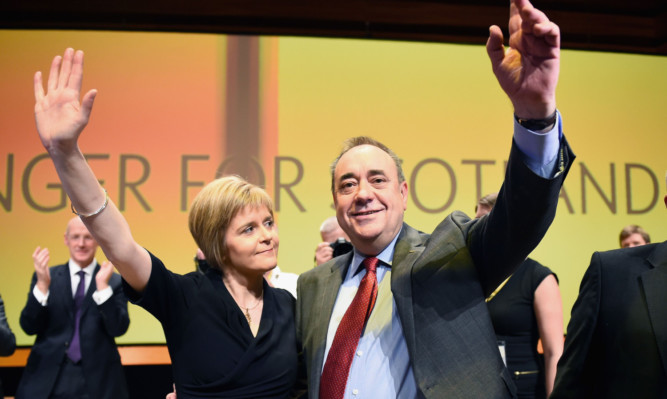
From first steps into politics to First Minister just don’t call her a nippy sweetie extracts from David Torrance’s Nicola Sturgeon biography.
It was the most important issue of Alex Salmond’s career yet the First Minister was happy to let deputy Nicola Sturgeon run the show.
Last year’s referendum was the moment that Salmond had worked towards his whole political life and the White Paper was his party’s crucial blueprint for an independent Scotland.
However, the normally controlling then-First Minister allowed Sturgeon to take the reins on the document.
“She took ownership of the White Paper,” recalled a ministerial colleague.
“That was her baby she was in charge of the whole thing.”
It was a stunning show of faith in the abilities of his No. 2 and a reflection of just how close a working relationship the pair had.
That particular political partnership had started in the summer of 1990 when a 19-year-old Sturgeon threw herself into the ‘Youth for Salmond’ campaign.
“Even then, she was a formidable operator,” recalled Kathleen Caskie, who worked at the SNP’s HQ at the time.
“She was in her late teens and a leading light in the SNP’s youth movement. She came into her own delivering the youth vote for Alex Salmond. Suddenly there were all these young people wearing Salmond T-shirts.
“The party was still at 15% in the polls and nobody had ever seen that level of organisation for an internal campaign before. That was the stage that her relationship with him cemented.”
The Glasgow constituency of Govan has a special place in the history of the Nationalist movement in Scotland.
It was also to become central to Sturgeon’s transition from activist to elected parliamentarian. Her bid to win the seat dominated the first decade of her career, which blossomed as her peers recognised her talent.
Her appointment as the party’s energy spokeswoman in the autumn of 1996 boosted her media profile further.
It offered her a platform to rail against rising electricity prices, safety at Dounreay and Westminster’s handling of North Sea oil revenue.
The issues at play in Govan housing, poverty and unemployment also played to her policy strengths.
Elected to the Scottish Parliament in 1999, Sturgeon refused to take an oath of allegiance to the Queen as she was sworn in, instead dedicating it to the sovereignty of the people of Scotland.
Sturgeon quickly became part of John Swinney’s ‘inner circle’ when he became leader and was the most prominent of his frontbenchers.
Indeed, it is likely Salmond encouraged the two to work closely together to form the starting point of a leadership ‘troika’ past, present and future that would dominate the SNP for the next decade-and-a-half.
On a personal level, she worked tirelessly to shed the ‘nippy sweetie’ moniker that had dogged her early career.
Her public persona, recalled a frontbench colleague, was “very one-sided”.
They added: “I got the impression she felt the ‘nippy sweetie’ tag was unfair and that she had to convey something else in order to combat it.”
The bid to bin that image took on greater emphasis when she had the chance of becoming leader in 2004. However, she eventually stood aside to allow Salmond to return.
Her strong performance as deputy meant she had consolidated her position, not only as his No. 2, but as the next No. 1.
Another senior colleague reflected: “Alex came to rely more on her. Yes, she complemented his rougher edges, but sometimes she could be harder and him softer, although that usually got overlooked.”
In this context, her involvement in the the White Paper was a significant development.
Pulling together material for the lengthy document was a huge logistical task, but one well-suited to the methodical Deputy First Minister.
Sturgeon became, in the words of one adviser, the “main interface between the party, government and the wider Yes movement”.
“She very deliberately took that role and made it her own,” recalled the aide. “She had his absolute confidence.”
Salmond was happy with this situation according to another insider, who claimed he increasingly came to view his deputy as “material to his own success”.
Although outwardly loyal, Sturgeon would often politely contradict or distance herself from things Salmond said.
And those who attended Scottish Cabinet meetings noticed she was “the only one who would and could challenge” him in front of colleagues.
Privately, according to former advisers, Sturgeon could be quite critical of her boss, comically rolling her eyes as she recounted his latest verbal.
Strikingly, unlike Salmond himself, there is little evidence of Sturgeon plotting and scheming her way to the top of the SNP.
She relied upon hard work and her own kudos in the party.
However, several months into her leadership, Salmond remained a looming presence.
Some Nationalists referred to him as the ‘RFM’ the ‘Real’ or ‘Rogue’ First Minister. The fact Sturgeon constantly had to tell interviewers she was now SNP leader was an unwelcome distraction from the task at hand.
Nicola Sturgeon: A Political Life by David Torrance is released on Monday, March 23, published by Birlinn, priced £9.99.

Enjoy the convenience of having The Sunday Post delivered as a digital ePaper straight to your smartphone, tablet or computer.
Subscribe for only £5.49 a month and enjoy all the benefits of the printed paper as a digital replica.
Subscribe